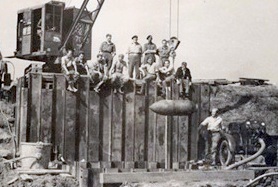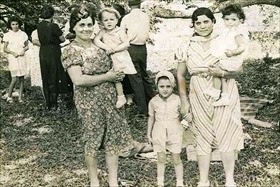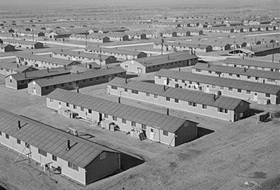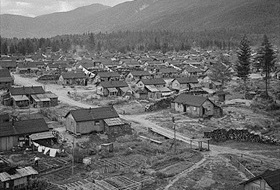BRITISH INTERN GERMANS, ITALIANS
London, England · June 25, 1940
Under the threat of imminent invasion from Nazi Germany, the British government on this date in 1940 began interning all suspect aliens living in the United Kingdom. Some 300,000 Germans, Austrians, and Italians, including Jewish refugees from the Nazis, were placed behind barbed wire in England (racetracks and unfinished housing projects were typical locations), on the Isle of Man (between Britain and Ireland), or deported to Canada or Australia (7,000 internees). The botched Allied campaign to assist Norwegians fighting German invaders (April 9 to June 10, 1940) and the rescue of some French citizens during the evacuation of the British Army at Dunkirk (May 27 to June 4, 1940) led to an outbreak of spy fever and agitation against enemy aliens. And so all males in Britain aged 16–60 who held enemy citizenship were interned—women only if under actual suspicion. Four days later President Franklin D. Roosevelt signed the Alien Registration Act (Smith Act), which required non-citizen adult residents living in the U.S to register and be fingerprinted. Within four months of its passage, close to five million U.S. aliens had registered, including 40,000 Japanese. Following on the Smith Act, Roosevelt’s Executive Order 9066 of February 19, 1942, authorized the Secretary of War and U.S. armed forces commanders to declare parts of the U.S. military areas “from which any or all persons may be excluded.” The order led to the forced relocation, usually to backwater areas of the U.S., of many of the same people, citizens and aliens alike, who had registered under the Smith Act. Of all alien internment, the most brutal was that organized by the Japanese after their armed forces flooded into British, Dutch, and American colonies and territories in the Asia Pacific region following the outbreak of the Pacific war in December 1941. In 1941–1942 approximately 130,000 civilians from Allied countries were interned. The camps varied in size; some were segregated by race or gender, but many were mixed gender. One of the largest unsegregated camps was in Hong Kong, which held 2,800 mainly British internees. Unlike prisoners of war, the internees were not compelled to work, but they were held in primitive conditions. Brutality by camp guards was common and internee death rates were high.
[amazon_carousel widget_type=”ASINList” width=”600″ height=”200″ title=”Recommended Reading” market_place=”US” shuffle_products=”False” show_border=”False” asin=”1599557967,1439183244,1410927121,0393330907,0316831301,0803228066,1890771406,1890771309,0939165538,1470168162″ /]
Wartime Internment of Enemy Aliens in Different Parts of the World
 |  |
Left: Huyton near Liverpool, England, was the site of three wartime camps: an internment camp, a German POW camp opened in 1943 (closed in 1948), and a base for U.S. servicemen. The internment camp, one of the biggest in Britain, was created to accommodate “enemy aliens” deemed a potential threat to national security. Prime Minister Winston Churchill’s demand to “collar the lot” meant that around 27,000 people ended up being interned. This picture shows Huyton inmates carrying out bomb disposal.
![]()
Right: When Italy declared war on Britain in June 1940, almost 5,000 Italians living in Australia were herded off to local prisons to be fingerprinted, photographed and numbered, hustled at gunpoint onto trains with barred windows, and sent to Australia’s internment camps or forced to perform forced labor with the Civil Alien Corps from 1943 to 1947. This photograph shows the families of the interned men of the Caminiti clan in Queensland sometime in 1940.
 |  |
Left: The Granada War Relocation Center (also called Camp Amache) was a Japanese American internment camp located in the hot, treeless, unpopulated southeast corner of Colorado (truly in the middle of nowhere) roughly 200 miles from Denver and not too far from the Kansas border. The camp opened in August 1942 and had a maximum population of 7,318 persons. Nearly all of those interned at the camp came from the populous West Coast, mostly from the Los Angeles area. Each internee was only allowed to bring one bag or suitcase; therefore, many people were forced to sell what they could or give away their possessions (including pets) before their forced relocation. Adding to the number of Japanese American internees (over 110,000) were 11,000 people of German ancestry and 3,000 people of Italian ancestry, along with some Jewish refugees.
![]()
Right: An unnamed internment camp for Japanese Canadians in British Columbia, June 1945. Over 75 percent of Canadian internees were Canadian citizens. Loyalties of Italian and German Canadians were questioned, too. Italian Canadians were considered to be fascist sympathizers and potential terrorists, so they were put under surveillance. Eventually 31,000 Italian Canadians were designated “enemy aliens.” Of these, about 600 were taken from their families and held in prisons and remote camps like the one in this photo.
Wartime Propaganda Film Justifying the Forcible Removal and Internment of Japanese Residents in U.S.
![]()

 History buffs, there is good news! The Daily Chronicles of World War II is now available as an ebook for $4.99 on Amazon.com. Containing a year’s worth of dated entries from this website, the ebook brings the story of this tumultuous era to life in a compelling, authoritative, and succinct manner. Featuring inventive navigation aids, the ebook enables readers to instantly move forward or backward by month and date to different dated entries. Simple and elegant! Click
History buffs, there is good news! The Daily Chronicles of World War II is now available as an ebook for $4.99 on Amazon.com. Containing a year’s worth of dated entries from this website, the ebook brings the story of this tumultuous era to life in a compelling, authoritative, and succinct manner. Featuring inventive navigation aids, the ebook enables readers to instantly move forward or backward by month and date to different dated entries. Simple and elegant! Click 











